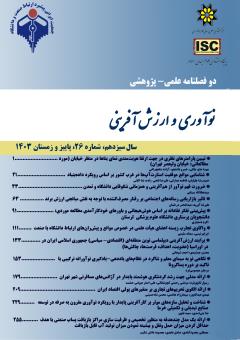واکاوی تجارب زیسته اعضای هیأت علمی در خصوص موانع و پیش ران های ارتباط دانشگاه با صنعت
محورهای موضوعی : Development of interactive networks
ابراهیم نیسی
1
![]() ,
سمانه سلیمی
2
,
سمانه سلیمی
2
![]()
1 - گروه مدیریت آموزشی، مؤسسه آموزش عالی مهراروند، آبادان، ایران
2 - گروه آموزش علوم تربیتی، دانشگاه فرهنگیان، تهران، ایران
کلید واژه: دانشگاه, صنعت, ارتباط دانشگاه با صنعت, دانشگاه نسل سوم,
چکیده مقاله :
هدف پژوهش حاضر، واکاوی تجارب زیسته اعضای هیأت علمی دانشگاه در خصوص موانع و پیش ران های ارتباط دانشگاه با صنعت بود. روش پژوهش، کیفی از نوع پدیدارشناسی بود. قلمرو تحقیق در این پژوهش اعضای هیأت علمی دانشگاه شهید چمران اهواز به تعداد 600 نفر بوده است. نمونه مورد نظر 15 نفر به صورت هدفمند متناسب با اشباع نظری انتخاب شدند. روش گردآوری اطلاعات در بخش کیفی مصاحبه نیمه ساختمند بود. جهت انجام روایی از روش بررسی توسط اعضا و برای بررسی پایایی از روش پایایی توافق بین دو کدگذار استفاده شده است. تجزیه و تحلیل مصاحبه ها با استفاده از روش تحلیل مضمون انجام گرفت. یافته ها نشان داد که از نظر اعضای هیأت علمی در بخش موانع 81 مضمون اولیه، 13 مضمون فرعی، 3 مضمون اصلی (موانع دانشگاهی، موانع ساختاری و محیطی و موانع مالی و نظارتی) و در بخش پیش ران ها70 مفهوم اولیه، 13 مضمون فرعی، و 6 مضمون اصلی (بازنگری در ساختارها، بازنگری قوانین و آئیننامه های مربوطه، تأمین منابع مالی، رعایت فرایند علمی و اصولی برای گرفتن طرحهای پژوهشی، به کارگیری مدیران متخصص و شایسته در جهت تسهیل ارتباط و تغییر باورها) قابل دستیابی است. بر اساس یافته های حاصل شده، در ارتباط دانشگاه با صنعت، موانعی هم مربوط به دانشگاه و هم مربوط به صنعت وجود دارد که هر دو باید در جهت رفع آن تلاش کنند و می توانند از پیش ران هایی که در این مقاله بدست آمده برای مطلوب کردن ارتباط دانشگاه با صنعت بهره ببرند.
The aim of this study was to analyze the lived experiences of faculty members about the barriers and drivers of the university-industry relationship. The research method was phenomenology a form of qualitative research. The study population includes 600 faculty members of Shahid Chamran University of Ahvaz. The intended sample consisting 15 people were purposefully selected according to the theoretical saturation. Data collection procedure in the qualitative part was a semi-structured interview. Review by members and inter-coder agreement have been used to evaluate the validity and reliability of the study, respectively. The interviews were analyzed using thematic analysis method. The findings indicated that from the point of view of the faculty members 81 primary themes, 13 sub-themes, and 3 main themes (academic, structural, and environmental barriers and financial and regulatory barriers) and 70 primary themes, 13 sub-themes, and 6 main themes (revision of the structures, relevant rules and codes, financing, observing the scientific and doctrinaire process to obtain research projects, recruiting expert and competent managers to facilitate communication and changing beliefs) are achievable in part of barriers and drivers, respectively. According to the findings obtained, there are barriers to university-industry relationship that are both university and industry-related; both must try to remove the barriers and they can enjoy the drivers provided in this article to optimize the university-industry relationship
